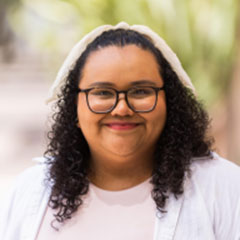In school districts across the country, paraeducators may be referred to as teacher aides, teacher assistants or instructional aides. They’re all individuals who work in schools under the supervision of a licensed educator and provide support to teachers and students. They may work with students to reinforce learning, implement behavior intervention plans or work closely with school nurses to support students’ medical needs. They may lead small reading groups or assist in planning mini-lessons with their lead teacher. Some are working towards becoming licensed educators. In Arizona and states around the country, they might also be a part of a Next Education Workforce ™ team-based model, where their skills are strengthened through collaboration.
The Next Education Workforce initiative at Arizona State University’s Mary Lou Fulton College for Teaching and Learning Innovation seeks to provide all students with deeper and personalized learning by building teams of educators with distributed expertise and empowering educators by developing better ways to enter the profession, specialize and advance. Paraeducators are a vital building block in the Next Education Workforce and as we began to look deeper into their roles, we found that little data exist on who paraeducators are and what they want out of their careers.
According to the U.S. Bureau of Labor Statistics, in 2021, there were approximately 1.2 million paraeducators in the United States, making up more than a quarter of the education workforce. In the largest school district in Arizona, Mesa Public Schools, there were approximately 1,099 paraeducators in the 2021–22 school year. This means that for every three educators, there is one paraeducator contributing to the classroom. Yet, there is still so little we know about paraeducators.
A survey was sent to paraeducators in Mesa to further understand this important role, their needs and aspirations. Below, we share insights from more than 500 paraeducators who responded to our survey.
Key Findings
Many paraeducators in Mesa Public Schools are not interested in becoming teachers.
44% of paraeducators expressed they were not interested in becoming a teacher in the next five years and 32% said they were unsure. They attributed their age as the reason for not pursuing a career in teaching and felt it didn’t make sense since retirement was quickly approaching. Some shared that the stress that comes along with teaching would impact their overall health. Many work in traditional one-teacher, one-classroom models that ask educators to be all things to all students at all times — and paraeducators observing those working conditions are aware of the stress it can cause. Other reasons paraeducators aren’t interested in becoming teachers include:
- Time commitments
- Responsibilities and demands of teaching
- Lack of respect from students and parents
- Lack of support from school leaders and staff
- Low pay for hard work
Paraeducators who want to pursue a teacher certification in the next 5 years

Only 24% of paraeducators surveyed said they would be interested in becoming teachers within the next five years. When asked what their top reason was for wanting to become a certified teacher, 39% communicated it was because they wanted to make a difference, 31% responded that they just wanted to work with students and 27% said that they enjoyed teaching and working with students.
Only a small percentage of paraeducators are actively pursuing a degree that leads to teacher certification
Of the 24% of paraeducators interested in becoming teachers (n =21), only 30 individuals are currently enrolled in a program that will lead to teacher certification. This could be attributed to the fact that there are still many barriers to higher education, such as the cost of a degree and the time needed to dedicate to school work. When asked what is not attractive about the path to becoming a certified teacher, paraeducators commonly cited age, cost and time commitments as significant deterrents on the path toward obtaining a degree. The average age of paraeducators, according to MPS HR data, is 45 years old, whereas the average age of a college student is 18–24. The average age of paraeducators who want to pursue a degree with teacher certification is 34 years old. On the other hand, the average age of paraeducators who aren’t interested in a degree with certification is 54 years old.
Paraeducators’ response to whether they were enrolled in a program that leads to teacher certification
(Sample size = 507)

Paraeducators enjoy their jobs
When asked what their employment plans for the next school year were, 86% shared that they were choosing to stay in the same role, and voiced that they enjoyed their job. Paraeducators expressed that they are happy and find fulfillment in their current roles and that they enjoy working with students and with educators. One paraeducator stated, “I have been in this role for 22 years and I still love what I do.” Another said, “I enjoy my job, I love working with kids!” Other paraeducators expressed that their coworkers and staff make it worthwhile for them to return to their roles. These findings suggest that more attention should be paid to redesigning the paraeducator role to allow for growth opportunities without having to become a certified teacher. Paraeducators are a core component of the educator workforce and enjoy what they do. Providing advancement pathways for paraeducators that are not only attractive but sustainable is a way to retain paraeducators that are not returning to their role.
Most rewarding career I’ve ever had … it’s a joy and honor to work with my team and students …
Paraeducator in Mesa Public Schools
Looking Forward
Understanding the landscape of paraeducators is an important step in designing resources, pathways and advancement opportunities for paraeducators. What we found from paraeducators will help inform the work that is yet to come from the Next Education Workforce initiative.
If only 24% of paraeducators want to become certified teachers, what are we doing to knock down barriers so that they can become teachers? If the remaining 76% don’t want to become teachers or are unsure, how can we build specialization and advancement pathways in the profession — supporting their growth as paraeducators, and developing just-right resources for their roles and responsibilities? As part of our Teacher-School Leader grant (TSL) from the U.S. Department of Education, we will continue to learn more about paraeducators — an essential building block of the Next Education Workforce models.
Notes about the author:
Isabel Alfaro has worked in higher education since 2018. She was formerly a program coordinator with the Next Education Workforce working with paraeducators.



